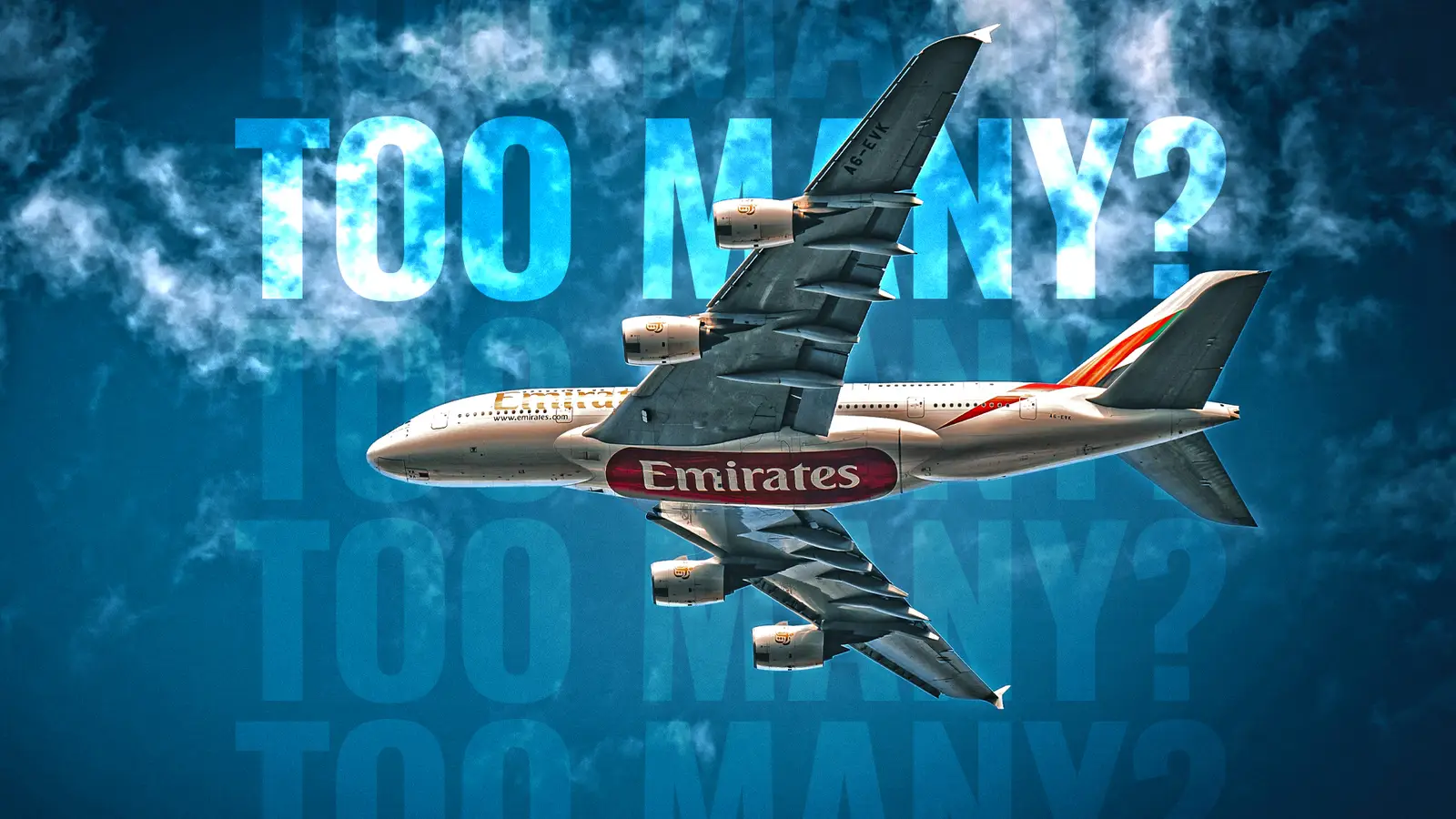Copyright Simple Flying

Emirates' relationship with the Airbus A380 is one of the most significant partnerships in modern aviation. When Airbus launched its double-deck super jumbo in the early 2000s, few could have predicted that a single airline would come to define the aircraft’s legacy. Emirates not only became the largest operator of the A380 but also built much of its brand identity around it. With almost 120 units available, the Dubai-based carrier’s fleet dwarfs that of all other airlines combined. However, as the world of aviation evolves, questions persist: has Emirates over-invested in an aircraft that no longer fits the modern air travel landscape? The A380 was designed for a world of constrained airport slots and Hub and Spoke networks, but trends have shifted toward smaller, more flexible twin-engine jets that connect secondary cities directly. With rising fuel costs, fluctuating demand, and changes in traveler behavior, some argue that Emirates’ reliance on so many A380s may now pose strategic and financial risks. The Rationale Behind The A380 Fleet Emirates’ large A380 fleet was born from a deliberate and calculated strategy. Dubai International Airport’s location, midway between Europe, Asia, and Africa, makes it ideal for connecting long-haul travelers via a single hub. The A380 perfectly suited this model: enormous capacity, long range, and the ability to funnel hundreds of passengers through a single transfer point. The airline also leveraged the A380 as a brand differentiator. Passengers associate the aircraft with an unmatched onboard experience with private suites, onboard showers, a bar lounge, and quieter cabins. Even economy passengers benefit from the aircraft’s comfort and space, reinforcing Emirates’ image as the world’s premium global carrier. This image helped justify higher fares and build loyalty, feeding into a self-reinforcing cycle of demand and prestige. Furthermore, Emirates believed the A380 offered long-term cost advantages for congested airports. When slots are scarce, carrying more passengers per movement increases profitability. On routes like London-Dubai or Sydney-Dubai, where Emirates often operates multiple daily A380s, this efficiency has become a powerful advantage. In short, the A380 was not a vanity project, it was a deliberate attempt to maximize hub throughput, brand prestige, and scale economies in a growing global market. Are the Numbers Still Working? From an economic perspective, the A380’s story is complicated. When full, the aircraft delivers impressive seat-mile economics, often outperforming smaller planes on high-density routes. Emirates configured many of its A380s to carry over 500 passengers, achieving some of the lowest costs per seat in the industry. According to some reports, a high density A380 can be up to 4% more fuel-efficient per seat than a Boeing 787-9 when operating at capacity. This demonstrates that, at its best, the A380 remains competitive in terms of operating efficiency. However, that efficiency collapses when load factors fall. Large aircraft magnify both profits and losses; when seats go unsold, fixed costs stay high. Data from fleet analytics firm IBA shows that Emirates’ average daily utilization of the A380 has fallen sharply since the aircraft’s early years, with flight hours per aircraft dropping more than 60% at certain points. This reduction reflects both changing demand and operational limitations. The A380 cannot easily be redeployed on thinner routes, limiting flexibility when markets fluctuate. Another challenge is maintenance and lifecycle costs. With Airbus ceasing A380 production in 2021, Emirates is locked into maintaining a unique and aging fleet without manufacturer support for new units. Upgrades and overhauls are expensive, and spare parts will become scarcer. While Emirates has invested billions in cabin refurbishments to extend service life, each additional year of operation raises questions about opportunity cost. Could those resources be better spent on more efficient next-generation aircraft? Fleet Risk And Market Evolution By tying much of its network capacity to one aircraft type, Emirates faces structural risk. The global aviation market has moved away from the hub-and-spoke model that the A380 was designed for. Modern twin-engine aircraft, like the Boeing 787 and Airbus A350 can fly long distances efficiently, enabling airlines to connect smaller cities directly without relying on massive hubs. This trend threatens the A380’s foundational logic. If point-to-point travel continues to grow as expected, Emirates may find itself with too much capacity concentrated across too few aircraft types. The A380’s size means it cannot serve smaller markets profitably, while competitors with flexible fleets can adapt more easily. Additionally, as sustainability pressures mount, four-engine aircraft face scrutiny for their higher absolute fuel burn and emissions. This reputational factor may become increasingly important in shaping customer and governmental sentiment. Tim Clark has publicly argued that other airlines’ reluctance to adopt the A380 “sabotaged” the aircraft’s potential. He contends that if more carriers had embraced the model, Airbus could have continued development, improving efficiency and costs. Yet, the reality remains that market demand favored smaller, more versatile aircraft. Emirates now shoulders the legacy of that imbalance, carrying the torch for an aircraft that the rest of the world largely moved beyond. Branding, Prestige And The A380 Effect Despite economic drawbacks, Emirates’ A380 fleet provides immense intangible benefits, making it an aviation icon. Travelers often choose Emirates precisely because of the A380 experience. The onboard bar, showers in first class, and the sense of scale contribute to a feeling of exclusivity and quality unmatched in the sky. This branding advantage has measurable effects on ticket sales and customer loyalty. Passengers associate the carrier and aircraft with luxury, reinforcing the brand’s global prestige. The aircraft’s iconic presence at major airports across the globe serves as a rolling billboard for Dubai itself. In a sense, the A380 helped turn Emirates into a cultural ambassador, projecting soft power for the UAE. Moreover, the A380’s presence influences how airports and regulators interact with Emirates. Many major hubs have invested in double-deck boarding gates and infrastructure to accommodate the super jumbo, cementing Emirates’ importance as a global partner. This relationship could translate into favorable slot allocations and long-term positioning. Thus, while some argue Emirates operates “too many” A380s, others contend that the sheer visibility and influence the aircraft generates more than justify their costs. The Argument That Emirates Operates Too Many Still, the question remains: has Emirates crossed the line from strategic dominance into over-commitment? Many critics believe so. Most other airlines that experimented with the A380, including Lufthansa, Air France, and Singapore Airlines, have either retired or drastically reduced their fleets. Their reasoning was simple: the aircraft is too large for most routes, too costly to operate when underfilled, and too inflexible for dynamic scheduling. Emirates’ decision to maintain over 100 active A380s, therefore, stands out as a high-risk strategy in a market favoring smaller planes. On Reddit discussions, aviation enthusiasts often point out that Emirates’ unique hub structure justifies its A380 fleet size, but only to a point. One commenter summarized: “The benefits of large aircraft are huge at airports like London and New York, where slots are maxed out. But if demand shifts, those planes become anchors.” That logic captures the airline’s dilemma. Emirates’ A380 fleet thrives on ultra-busy routes, but those same aircraft become liabilities when demand fluctuates. Moreover, Emirates’ reliance on the A380 constrains its fleet agility. Unlike competitors that can swap between Boeing 787s or Airbus A350s depending on route strength, Emirates’ network planning must constantly ensure high load factors to sustain profitability. The result is a fleet that’s brilliant when full, brittle when not. In the long run, having “too many” A380s may limit Emirates’ capacity to pivot with global travel trends, a potential Achilles’ heel masked by years of success. Looking Ahead: Balancing Legacy and Future Strategy Emirates’ future will depend on how it balances its iconic A380 fleet with a new generation of aircraft. The airline has already ordered dozens of the Boeing 777X and Airbus A350, signaling an intent to diversify. These aircraft offer comparable range with significantly lower fuel burn and greater deployment flexibility. In Tim Clark’s words, the A380 “will remain our flagship,” but newer models will “carry the baton forward” for efficiency. The airline’s ongoing refurbishment program, upgrading A380 cabins with new premium economy seats and refreshed interiors, indicates that Emirates plans to keep the aircraft flying well into the 2030s. However, the question is not whether the A380 still has value, but whether Emirates can sustain such a large proportion of its capacity in one aging type. If global demand softens, fuel prices rise, or environmental regulation tightens, the airline may face mounting pressure to scale back. Ultimately, Emirates’ heavy reliance on the A380 reflects both vision and vulnerability. The aircraft propelled the airline to global prominence and helped define modern luxury air travel. Yet the same scale that once symbolized power now introduces risk in an era favoring adaptability and efficiency. Whether Emirates operates “too many” A380s may depend less on today’s profits and more on tomorrow’s flexibility. The A380 remains Emirates’ crown jewel, but it is also its greatest test.



